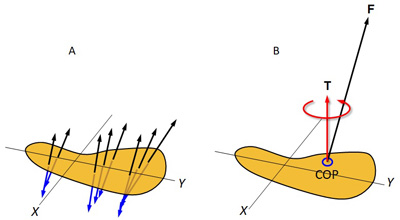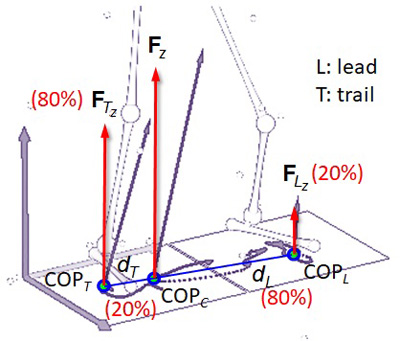Home > Foundation > Ground Reaction Force/Moment
Ground Reaction Force and Moment
Ground reaction force is the reaction supplied by the ground: i.e., the reaction to the force the golfer exerts to the ground. The foot interacts with the ground through the entire contact area (Figure 1A). The blue arrows in Figure 1A are the forces the foot exerts to the ground while the black arrows are their reactions. This multi-force system (formed by individual reaction forces) can be reduced to a simpler but mechanically equivalent system with a net force (ground reaction force; GRF; F in Figure 1B) and a net moment (ground reaction moment; GRM; T in Figure 1B) only. GRF is the sum of all reaction forces acting on the foot. GRM, on the other hand, is the sum of the moments produced by the individual reaction forces about the center of pressure (COP). COP is GRF's point of action.

Figure 1. Ground reaction force (F) and moment (T), and center of pressure (COP)
COP is not just an arbitrary point within the contact area but a unique point that should suffice specific requirements. As shown in Figure 2A, each reaction force ( ) generates a moment about the COP (
) generates a moment about the COP ( ). GRM is the sum of all these. COP in fact is the point of balance of these moments so the horizontal components of the net moment become zero (Figure 2B). As a result, GRM has only one non-zero component, the vertical component (
). GRM is the sum of all these. COP in fact is the point of balance of these moments so the horizontal components of the net moment become zero (Figure 2B). As a result, GRM has only one non-zero component, the vertical component ( ).
).

Figure 2. Center of pressure (COP). Ground reaction moment (A) is sum of the moments produced by individual reaction forces about the COP. The horizontal components of the GRM are all zero, which makes the COP the balance point of the horizontal moments (B).
A typical pressure mat system (such as Swing Catalyst®) has an array of sensors and measures the vertical forces acting on the individual sensors. The location of the COP can be computed from these vertical forces (Figure 3). This is beacuse the vertical forces acting on the ground ( ) can still generate horizontal moments about a given point on the ground within the contact area and the COP can be located by balancing the horizontal moments. In this case, however, computation of the vertical moment (
) can still generate horizontal moments about a given point on the ground within the contact area and the COP can be located by balancing the horizontal moments. In this case, however, computation of the vertical moment ( ) is not possible as the vertical forces acting on the ground cannot generate moment about the vertical axis. A pressure mat provides the COP location and the vertical component of the GRF as well as the pressure map.
) is not possible as the vertical forces acting on the ground cannot generate moment about the vertical axis. A pressure mat provides the COP location and the vertical component of the GRF as well as the pressure map.

Figure 3. COP revisited. A pressure mat (or plate) provides the COP location as it can be computed from the vertical components of the reaction forces acting under the foot.
The GRFs acting on individual feet can be combined into single force, combined GRF (Figure 4). The combined GRF acts at the combined COP. The combined COP must lie on the straight line connecting the individual COPs (lead side and trail side). The location of the combined COP is essentially determined by the magnitudes of the vertical GRFs acting on the individual feet. For example, if 80% and 20% of the combined vertical force are acting on the trail foot and the lead foot, respectively, the combined COP divides the line connecting the individual COPs 20:80. This way the horizontal moments generated by the individual GRFs about the combined COP become balanced.

Figure 4. Combined COP. The location of the cpmbined COP reflects the relative magnitudes of the vertical GRFs acting on the feet.
Remember here that the location of the combined COP only reflects the relative magnitudes of the vertical forces acting on the individual feet and has nothing to do with the position of the center of mass (COM) of the golfer's body. Therefore, 'COP shift' and 'weight shift' shouldn't be used synonymously.
A pressure mat reports the combined and individual COP locations and the combined and individual vertical forces. A 'force plate' reports the combined GRF/GRM (all three components) and the combined COP location. Use of two force plates, one foot on each plate (which is the standard in typical biomechanical research), enables the calculation of various moments golfers generate through the golfer-ground interaction. See the Golfer-Ground Interaction Moments page for this.
Top